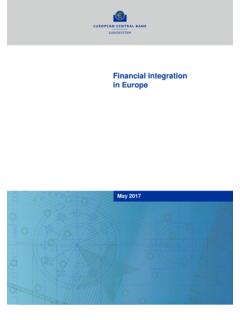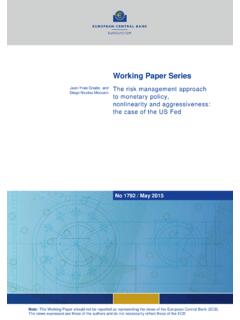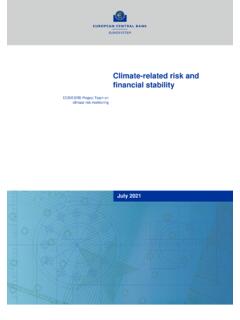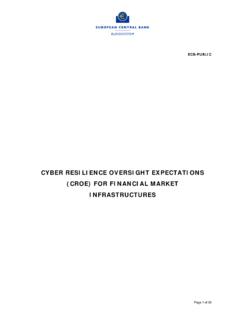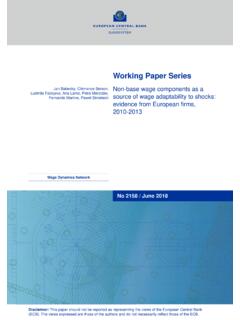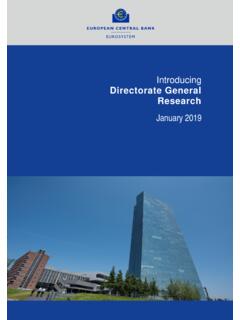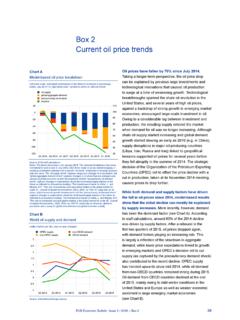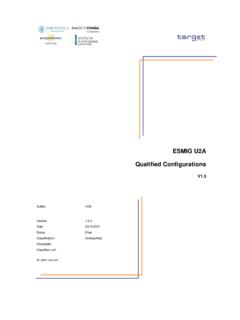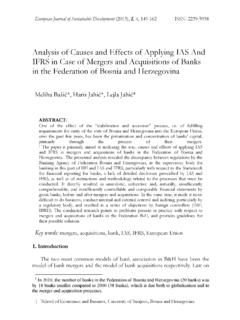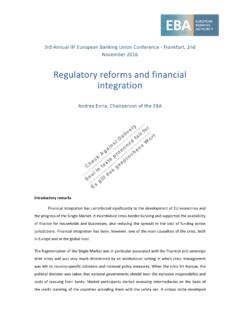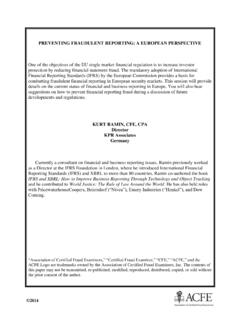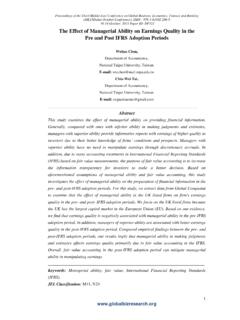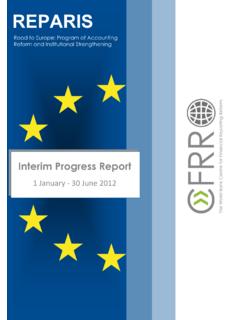Transcription of THE TRANSFORMATION OF THE EUROPEAN FINANCIAL …
1 Second ECBC entral banking ConferenceFrankfurt am Main24 and 25 October 2002 THE TRANSFORMATION OF THE EUROPEANFINANCIAL SYSTEMCONFERENCE The views expressed in this paper are those of the author(s) and do not necessarilycorrespond to the views of the EUROPEAN Central banking : PAST, PRESENT ANDFUTUREJean DermineEUROPEAN banking , Past, Present and Future Jean DermineINSEAD, FontainebleauOctober 2002 Paper to be presented at the Second Central banking Conference, 24-25 October 2002, author is most grateful for insightful discussions with R. Pijpers, R. Schipper, and D. vanWassenaer of ING Group, T. Arnerup, Nordstr m, and B. Ranhamn of Nordea AB,INSEAD colleagues P.
2 Fulghieri, S. Rangan, and M. Suominen, D. Schoenmaker (Dutch Ministryof Finance) for earlier discussions on related issues, and to J. Cropper for editorial assistance. Theauthor acknowledges the helpful comments on a first draft by V. Gaspar, R. Gropp, and of the EUROPEAN Central Bank. The usual caveat applies: The author is solelyresponsible for errors or omissions. EUROPEAN banking ,Past, Present and FutureJean DermineINSEAD, FontainebleauOctober 2002 Introduction1. EUROPEAN banking , from Fragmentation to Integration Developments in the Legal Environment banking with a Single Currency Additional Factors of Change Impact of the Single Market and the Euro2.
3 Single banking License, Single Home Country Regulator, Single Bankruptcy Proceedings : A Great Illusion ?3. The Economics of Bank Mergers Economic Rationale for Bank Mergers Gains from Bank Mergers, The International Empirical Evidence4. Mergers and Acquisitions in Europe, Three Public Policy Issues Investor Protection Systemic Risk Concentration and CompetitionConclusionTablesReferences-1- 1 EUROPEAN Commission (COM 83 207)2 OJL 169, directive on the application of Article 67 of the EEC Treaty, June document n/ 1759 April 1983, a White Paper on FINANCIAL integration1 by the EUROPEAN Commission called forfurther work to be done in order to achieve a better allocation of savings and investment in theEuropean Community.
4 Following various EUROPEAN councils, the 1986 Single EUROPEAN Act,2 the1998 Council directive on the liberation of capital movements,3 the 1992 Treaty on EuropeanUnion,4 the creation of the Euro in 1999, and the FINANCIAL Services Action Plan, legal barriersto an integrated EUROPEAN banking market have been progressively dismantled. Twenty years intothis TRANSFORMATION period, we review the impact of this legislation on the EUROPEAN bankingindustry, the commercial banks, their customers, and regulators. A review of this twenty-yearperiod will hopefully help to better understand the dynamics of the TRANSFORMATION and potentialfuture paper is divided into four sections. In Section 1, we review the history of EUROPEAN bankingintegration, the costs of non-Europe as they were evaluated in the mid-Eighties, and the welfarebenefits that have accrued to consumers.
5 In Section 2, we attempt to better understand theremaining barriers to the creation of a truly single EUROPEAN banking market. In particular, weargue that the concept of a bank with a single license operating with cross-border branches is morea myth than a reality. Indeed, cross-border consolidation very often appears to take the form ofsubsidiaries, not branches. We carefully examine the raison d tre of the many bank mergers,which took place between 1990 and 2002, in Section 3. The analysis covers not only the realsources of economies of scale and scope, but also the FINANCIAL sources resulting from a betterinternational diversification of risks. Finally, in Section 4, we address three public policy issuesraised by the process of consolidation: investor protection in international banking , the impact onbanking supervision, which, historically, has been conducted by each member state, and theimpact on competition and stability.
6 The main conclusions of the paper are summarized at the public policy implications to draw from the paper are fourfold: First, EUROPEAN countries ofsmaller size, such as the Netherlands and Switzerland, would face severe economic hardshipshould one of their large national banks defaults. Second, as banks often expand across borderswith subsidiaries, the winding up of such institutions would be quite complex. Moreover, theclosure of an international bank would likely have cross-border spillovers. Centralization, or atleast EUROPEAN -wide coordination, of the decision to close or bail out international banks wouldbe needed. Third, more legislative work appears necessary, not only to harmonize consumerprotection laws and national supervisory practices, but also to ensure that national corporate orvalue-added taxes do not hinder the creation of efficient EUROPEAN firms.
7 Fourth, if domesticconsolidation has contributed significantly to operating efficiency, it has increased the degree ofconcentration in several EU countries. Strict monitoring of the degree of competition in thebanking industry is needed in order to facilitate the growth of the small & medium size enterprise(SME) sector, which employs more than fifty percent of the labor force in the EUROPEAN 73/183, 1 . EUROPEAN banking , from Fragmentation to Integration A brief review of developments in the legal environment ( ) is followed by: ( ) an analysisof the specific impact of the Euro on the banking industry, ( ) an analysis of additional sourcesof change, and ( ) their twenty-year-impact on the integration of the EUROPEAN commercialbanking Developments in the Legal EnvironmentThe actions taken by the EUROPEAN Commission and the Council of Ministers can be divided intofive time periods.
8 Deregulation of entry into domestic markets from 1957 to 1973, variousattempts toward harmonization of regulations from 1973 to 1983, the 1992" directives regardinga single banking license, home country control, mutual recognition, and freedom of cross-borderservices, the creation of the single currency in 1999, and the FINANCIAL Services Action Plan(2001-2005). Deregulating Entry (1957-1973)The objective of the 1957 Treaty of Rome was the TRANSFORMATION of highly segmented nationalmarkets into a single common market. This objective was achieved by means of two types ofmeasures: The recognition of the right of establishment and the coordination of legislationwherever necessary.
9 In June 1973, the Council adopted a directive on The Abolition ofRestrictions on Freedom of Establishment and Freedom to Provide Services for self-employedActivities of Banks and other FINANCIAL This directive applies the national treatmentprinciple, which ensures the equal regulatory and supervisory treatment of all firms operating inone country. Although in 1973, entry restrictions could not be discriminatory, the objective of theinitial treaty was still far from being met. International competition, through the supply of cross-border services, was severely restricted by regulations on capital flows. Furthermore, there wasno coordination of banking supervision, so that banks operating in different countries could besubject to different rules.
10 This additional burden raised the costs of operating internationally. Thisled to the second phase of attempts to harmonize 77/780 on Supervision of Credit Institutions on a Consolidated Basis, on aUniform Format for Bank Accounts, and on Consumer Protection were adopted by 1987. Thefirst banking directive initiated work on Winding Up and Liquidation and on the of banking Regulations (1973-1983)Progress in harmonization came in 1977 with the adoption of the First banking Directive on TheCoordination of Laws, Regulations and Administrative Provisions Relating to the Taking Up andPursuit of Credit Institutions6. This directive established the principle of home country for the supervision of credit institutions operating in two or more member countrieswould gradually be shifted from the host to the home country of the parent bank.
